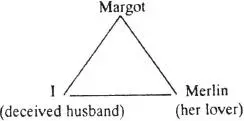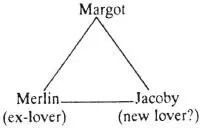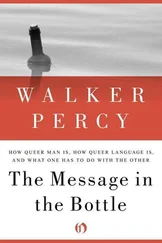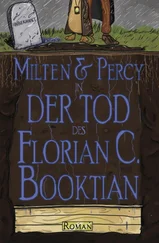MARGOT: DO you believe I still — you?
(Do you believe I still love you?)
MERLIN: Oh, Chr—
MARGOT: Sh — sh — sh!
(Shush shush shush? or: shit shit shit? shit shit shit.)
The tiny figurines embrace again, sectors of their trunks blowing out like pseudopods of amoebae. Their bodies seem to have magnetic properties.
MERLIN: —wish you — all happ—
(I wish y’all happiness? I wish you all happiness? The latter? Merlin wouldn’t say “y’all.”)
Merlin vanishes. Margot droops and is still, like a puppet hung from its string.
It is a triangle. At first I thought I was part of the triangle, the losing angle, so:

Then I see they are not talking about me at all, that it is a different triangle:

Another figure materializes (they don’t seem to use doors). It is Jacoby. There is no way of recognizing him except by his shortness and stockiness and his big head, which he carries confidently between his shoulders. Like many short men he is of a piece, body, brain, organs compacted and operating in close order. All would be well with him, one feels, except he is shorter than Margot. He makes up for this shortcoming by a kind of confident lolling back of head. It is his way of not having to look up at her; he holds her off as if to say: Well, my dear, let’s have a look at you.
They make a Y connected as far as the waist.
They do not speak but their mouths and eyes open on light. Are they whispering?
They dress, putting dark on light. No, it is undressing, for dark is light and light is dark. They are shedding light clothes for dark skin.
They approach each other. Sections of their bodies detach and fly off. Other sections extend pseudopods.
They turn, their hair blowing sideways in an electric wind. There are two sockets of light on Margot’s back. They are, I recognize, the two dimples on either side of her sacrum.
Margot lies across the bed and pulls him onto her. He is gazing down at her. Her head comes off the bed and bends back until her face is looking upside down at the camera. Her eyes close on light, but her mouth opens letting out light.
Still there is no conversation but presently a voice says, at first I think from my room or even from the sky with the blackbirds: Oh oh oh ah ah aaah, oh my Jesus oh ah ah sh — sh — sh —
???
But the voice is not immediately recognizable as either Margot’s or Jacoby’s, being hoarser than Margot’s and higher than Jacoby’s.
A prayer?
INTERMISSION
I switch off the machine and walk out into the skyey day. There is the blinded dazzled headachy sensation of coming out of a movie in the afternoon. The blackbirds are rising and settling, the wind has picked up but is fitful, blowing sycamore leaves back and forth across my tiny pigeon porch.
I sit on my porch and watch the blackbirds rising and settling and the clouds hurrying toward the hurricane like latecomers to the kickoff.
The blackbirds fall silent. The clouds straighten out and form a line. The sky becomes flat and yellow. The view from the porch is very simple. There are six parallel horizontal lines, the bottom rail of the iron fence, the top rail, the near edge of the River Road, the far edge, the top of the levee, the straight bottom line of the clouds. There are many short vertical lines, the iron spikes of the fence. There is a single oblique line, a gravel road leading from the River Road over the levee. Atop the levee are the triangles of the bonfires. The slanting boom of a ship intersects with the triangle of the bonfires, making trapezoids and smaller triangles.
The hurricane machine cranks up. The live oaks blow inside out. It is necessary to use the hurricane machine even though a real hurricane is coming, not just because the real hurricane is not yet here, but because even if it were it wouldn’t be as suitable for film purposes as an artificial hurricane.
SECOND FEATURE: MISS RAINES ROOM
There are three red figures on the pink bed. Pieces of bodies, ribs, thighs, torsos, fly off one body and join another body. Hair blows in a magnetic wind. Mouths and eyes open on light. Light pubic triangles turn like mobiles, now narrowing, now widening, changing from equilateral triangles to isosceles triangles to lines of light. The posters of the bed make a frame.
Lucy is lying lengthwise in the middle of the bed. She is recognizable by the flame-curl of hair under her ears, by her big breasts, and by the still slightly immature not wholly incurved line between calf and knee. Lucy is like a patient. Certain operations are being performed on her. The other two figures handle her as efficiently as nurses. Raine is slim and swift, moving so fast her body leaves ectoplasm behind. Dana stands naked and musing beside the bed, one hand browsing over his shoulder like an athlete in a locker room.
The three lie together. Their bodies fuse but their arms move like a six-arm Shiva.
Now they are doing something else. Dana kneels in a horizontal plane, takes Lucy’s head in both hands, and guides it toward him. Raine moves much more quickly. Her sleek head flies off and burrows into Lucy’s stomach.
The figures make a rough swastikaed triangle:

Elgin is right. The sound track is poor. No words are audible except near the end an unrecognizable voice which is neither clearly male or female seems to come from nowhere and everywhere — and only fragments at that: Oh Christ dear sweet Jesus oh oh —
Another prayer?
Crows begin to fly north against the wind. It is unusual to see crows in such numbers, flocking like blackbirds. Then they straggle out for a mile. Ellis Buell says crows are the smartest of all birds. This is probably true. At least I know for a fact they know the range of a shotgun (Fluker claims they can distinguish a twenty gauge from a twelve, then move just out of range). The only time I ever killed a crow was by pure luck and a.22 rifle. He was flying at least five hundred feet high. Without expectation I led him by three feet and shot him through the head. Surprised, he fell at my feet with a thump. A ruby drop of blood hung from his black bill.
Still I had to watch the 5:30 news!
Unhooking the videotape, I turned on the TV. The hurricane watch had been changed to a hurricane warning. Marie, two hundred miles due south, was headed due north. She filled the whole Gulf. It became necessary to make preparations.
Everyone became serious and happy.
Storekeepers seriously-happily boarded up their windows. Volunteers seriously-happily sandbagged the levee. Shoppers seriously-happily shopped for battery radios, batteries, flashlights, Coleman lamps, kerosene lamps, kerosene, candles, canned goods, powdered milk, dried apricots, Hershey bars, raisins.
Happiest and most serious of all were owners of fallout shelters dug out during the A-bomb scare many years ago and never used. Happy families huddled underground around TV sets showing Marie spinning ever closer.
Happy drinkers sat in friendly bars under the levee drinking Dixie beer and reminiscing about other hurricanes. Even householders of low-lying houses left home happily, headed for motels in the Mississippi hills. Ordinarily bored police rode happily up and down country roads and bayous warning people to evacuate.
I too made certain preparations. I made a shopping list but, unlike other shoppers, I first discarded certain objects before purchasing others. Assembling the video cameras, tape deck, tapes, recorder, amplifier — some $4,500 worth — I packed the lot in a Gladstone bag and at nightfall hauled it over the levee to a skiff locked to a cypress in the batture, rowed out two hundred yards, and dropped the bag in the channel. When I regained the batture I was half a mile downstream but it was easy rowing back in dead water.
Читать дальше















